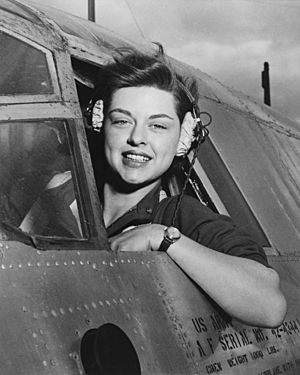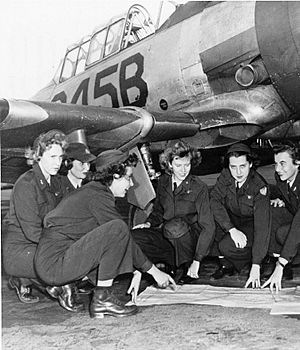Women Airforce Service Pilots facts for kids

The WASP badge
|
|
 Elizabeth L. Gardner, WASP member, at the controls of a B-26 Marauder |
|
| Agency overview | |
|---|---|
| Formed | August 5, 1943 |
| Preceding agencies |
|
| Dissolved | December 20, 1944 |
| Employees | 1,830 accepted for training 1,074 completed training |
| Parent agency | United States Army Air Forces |
The Women Airforce Service Pilots (WASP) was a special group of women pilots. They were civilians who worked for the United States federal civil service. Their main job was to help the country during World War II.
These brave women became highly trained pilots. They did many important tasks. This allowed male pilots to go fight in combat roles. The WASP program was not part of the military itself. It was a civilian organization.
Contents
Women Pilots in World War II
During World War II, many men went overseas to fight. This meant there were fewer male pilots available at home. The United States Army Air Forces needed more pilots to move planes and do other flying jobs. That's where the WASP came in.
The idea was to use skilled women pilots for non-combat flights. This would free up male pilots for dangerous missions. The WASP program officially started on August 5, 1943. It combined two earlier groups: the Women's Flying Training Detachment (WFTD) and the Women's Auxiliary Ferrying Squadron (WAFS).
What Did They Do?
The WASP pilots had many important duties. They flew almost every type of military aircraft. Their jobs were crucial for the war effort.
- Ferrying Aircraft: This was their main job. They flew new planes from factories to military bases. They also moved planes between bases for repairs or new assignments. This saved a lot of time and resources.
- Testing Planes: WASP pilots tested planes after they were built or repaired. They made sure the aircraft were safe and ready for combat.
- Training Pilots: Some WASP members became flight instructors. They taught male pilots how to fly different types of planes.
- Towing Targets: They flew planes that towed targets for gunnery practice. This was a dangerous job, as live ammunition was being fired.
- Transporting Personnel and Cargo: They also flew missions to carry people and supplies.
Becoming a WASP
To become a WASP, women had to be experienced pilots. They also had to pass tough training. Many women applied, but only the best were chosen. About 1,830 women were accepted for training. Out of these, 1,074 completed the program.
The training was very strict. It was similar to the training for male military pilots. They learned advanced flying skills and military procedures. Avenger Field in Texas was a main training base for the WASP.
One famous leader of the WASP was Jacqueline Cochran. She was a pioneering aviator herself. She helped create and lead the program.
Their Important Role
The WASP pilots flew over 60 million miles during the war. They delivered more than 12,000 aircraft. Their work was vital to the success of the United States Army Air Forces. They proved that women could fly military aircraft just as well as men.
Sadly, 38 WASP pilots lost their lives during their service. They died in accidents while performing their duties. Despite their bravery and sacrifices, the WASP members were not considered military personnel at the time. This meant they did not receive military benefits.
After the War
The WASP program was dissolved on December 20, 1944. This was because the war was winding down. Male pilots were returning home. The need for civilian women pilots decreased.
For many years, the WASP pilots fought for recognition. They wanted their service to be officially recognized as military service. In 1977, a law was passed that finally granted them veteran status. This was a huge victory for the WASP.
In 2009, the WASP were awarded the Congressional Gold Medal. This is one of the highest civilian awards in the United States. It recognized their courage, dedication, and important contributions during World War II. Their story is an inspiring example of women breaking barriers and serving their country.
Images for kids
-
Hazel Ying Lee in a Link trainer, 1944
-
Florene Watson shown preparing a P-51D-5NA for a ferry flight from a factory at Inglewood, California
-
Helen W. Snapp, flying for the Low-target Squadron, at Camp Stewart, Georgia June 1944
-
Jackie Cochran (center) with WASP trainees
See also
 In Spanish: Women Airforce Service Pilots para niños
In Spanish: Women Airforce Service Pilots para niños











